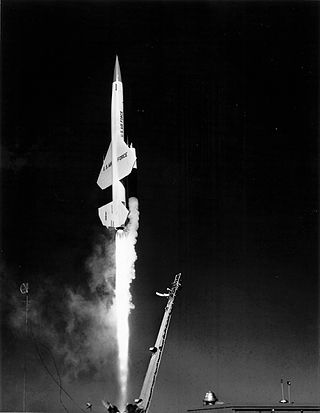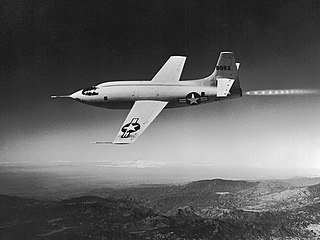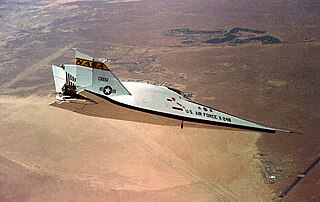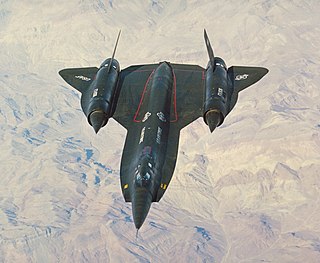
The Boeing CIM-10 Bomarc was a supersonic ramjet powered long-range surface-to-air missile (SAM) used during the Cold War for the air defense of North America. In addition to being the first operational long-range SAM and the first operational pulse doppler aviation radar, it was the only SAM deployed by the United States Air Force.

A ramjet is a form of airbreathing jet engine that requires forward motion of the engine to provide air for combustion. Ramjets work most efficiently at supersonic speeds around Mach 3 and can operate up to Mach 6.

Edwards Air Force Base (AFB) is a United States Air Force installation in California. Most of the base sits in Kern County, but its eastern end is in San Bernardino County and a southern arm is in Los Angeles County. The hub of the base is Edwards, California. Established in the 1930s as Muroc Field, the facility was renamed Muroc Army Airfield and then Muroc Air Force Base before its final renaming in 1950 for World War II USAAF veteran and test pilot Capt. Glen Edwards.

The Bell X-1 is a rocket engine–powered aircraft, designated originally as the XS-1, and was a joint National Advisory Committee for Aeronautics–U.S. Army Air Forces–U.S. Air Force supersonic research project built by Bell Aircraft. Conceived during 1944 and designed and built in 1945, it achieved a speed of nearly 1,000 miles per hour in 1948. A derivative of this same design, the Bell X-1A, having greater fuel capacity and hence longer rocket burning time, exceeded 1,600 miles per hour in 1954. The X-1 aircraft #46-062, nicknamed Glamorous Glennis and flown by Chuck Yeager, was the first piloted airplane to exceed the speed of sound in level flight and was the first of the X-planes, a series of American experimental rocket planes designed for testing new technologies.

The Republic XF-91 Thunderceptor is a mixed-propulsion prototype interceptor aircraft, developed by Republic Aviation. The aircraft would use a jet engine for most flight, and a cluster of four small rocket engines for added thrust during climb and interception. The design was largely obsolete by the time it was completed due to the rapidly increasing performance of contemporary jet engines, and only two prototypes were built. One of these was the first American fighter to exceed Mach 1 in level flight.

The Martin Marietta X-24 was an American experimental aircraft developed from a joint United States Air Force-NASA program named PILOT (1963–1975). It was designed and built to test lifting body concepts, experimenting with the concept of unpowered reentry and landing, later used by the Space Shuttle. Originally built as the X-24A, the aircraft was later rebuilt as the X-24B.

Cape Canaveral Space Force Station (CCSFS) is an installation of the United States Space Force's Space Launch Delta 45, located on Cape Canaveral in Brevard County, Florida.

The Lockheed YF-12 was an American Mach 3+ capable, high-altitude interceptor prototype, developed and manufactured by American aerospace company Lockheed Corporation.

The Douglas X-3 Stiletto was a 1950s United States experimental jet aircraft with a slender fuselage and a long tapered nose, manufactured by the Douglas Aircraft Company. Its primary mission was to investigate the design features of an aircraft suitable for sustained supersonic speeds, which included the first use of titanium in major airframe components. Douglas designed the X-3 with the goal of a maximum speed of approximately 2,000 mph (3,200 km/h), but it was seriously underpowered for this purpose and could not even exceed Mach 1 in level flight. Although the research aircraft was a disappointment, Lockheed designers used data from the X-3 tests for the Lockheed F-104 Starfighter which used a similar trapezoidal wing design in a successful Mach 2 fighter.

The Northrop X-4 Bantam was a prototype small twinjet aircraft manufactured by Northrop Corporation in 1948. It had no horizontal tail surfaces, depending instead on combined elevator and aileron control surfaces for control in pitch and roll attitudes, almost exactly in the manner of the similar-format, rocket-powered Messerschmitt Me 163 of Nazi Germany's Luftwaffe. Some aerodynamicists had proposed that eliminating the horizontal tail would also do away with stability problems at fast speeds resulting from the interaction of supersonic shock waves from the wings and the horizontal stabilizers. The idea had merit, but the flight control systems of that time prevented the X-4 from achieving any success.

The North American Aviation AGM-28 Hound Dog was a supersonic, turbojet-propelled, nuclear armed, air-launched cruise missile developed in 1959 for the United States Air Force. It was primarily designed to be capable of attacking Soviet ground-based air defense sites prior to a potential air attack by B-52 Stratofortress long range bombers during the Cold War. The Hound Dog was first given the designation B-77, then redesignated GAM-77, and finally AGM-28. It was conceived as a temporary standoff missile for the B-52, to be used until the GAM-87 Skybolt air-launched ballistic missile was available. Instead, the Skybolt was cancelled within a few years and the Hound Dog continued to be deployed for a total of 15 years until its replacement by newer missiles, including the AGM-69 SRAM and then the AGM-86 ALCM.

The Ryan X-13 Vertijet was an experimental tail-sitting vertical take-off and landing (VTOL) jet aircraft built by Ryan Aeronautical and flown in the United States in the 1950s. The main objective of the project was to demonstrate the ability of a pure jet to vertically takeoff, hover, transition to horizontal forward flight, and vertically land.

The North American SM-64 Navaho was a supersonic intercontinental cruise missile project built by North American Aviation (NAA). The final design was capable of delivering a nuclear weapon to the USSR from bases within the US, while cruising at Mach 3 at 60,000 feet (18,000 m) altitude. The missile is named after the Navajo Nation.

The Fairchild SM-73 was a planned sub-sonic, jet-powered, long-range, ground-launched decoy cruise missile. XSM-73 was the designation for the development version. Development began in 1952 with conceptual studies and ended when the program was canceled in 1958 after 15 test flights but before any operational deployment. The operational concept was to base squadrons of XM-73s at various locations in the United States and if necessary launch the aircraft as part of a strategic bomber attack. The aircraft would fly autonomously under inertial guidance towards the target area, using radar reflectors and electronic countermeasures to imitate American bombers and thus confuse and saturate enemy air defenses. The program was cancelled because the missile was not able to simulate a B-52 bomber on radar.

The ADM-160 MALD is an air-launched, expendable decoy missile developed by the United States. It uses gradient-index optics to create a radar cross section that simulates allies' airplane, in order to stimulate, confuse, and degrade the capability of missile defense systems. Later variants (MALD-J) are additionally equipped with electronic countermeasures to actively jam early warning and target acquisition radars.

The AQM-35 was a supersonic target drone produced by the Northrop Corporation.
The Burya was a supersonic, intercontinental cruise missile, developed by the Lavochkin design bureau under designation La-350 (Ла-350) from 1954 until the program cancellation in February 1960. The request for proposal issued by the Soviet government in 1954, called for a cruise missile capable of delivering a nuclear payload to the United States. Analogous developments in the United States were the SM-62 Snark and SM-64 Navaho cruise missiles, particularly the latter, which used parallel technology and had similar performance goals.

The Leduc 022 was the prototype of a mixed-power French interceptor built in the mid-1950s. Designer René Leduc had been developing ramjet-powered aircraft since before World War II and had flown a series of experimental aircraft, the Leduc 0.10 and Leduc 0.21, throughout the 1950s before he was awarded a contract for two examples of a short-range supersonic interceptor armed with two air-to-air missiles (AAMs).

The SNCASO SO.9000 Trident is a French mixed-power interceptor aircraft built by aircraft manufacturer SNCASO during the 1950s. As part of a wider effort to re-build French military power during the late 1940s and to furnish France with advanced, new domestically produced designs, a request for a supersonic-capable point-defence interceptor aircraft to equip the French Air Force was issued to SNCASO. In response, the firm designed the mixed-propulsion Trident, powered by a single SEPR rocket engine, which was augmented by wingtip-mounted turbojet engines, and the Air Force ordered two prototypes.

The 6555th Aerospace Test Group is an inactive United States Air Force unit. It was last assigned to the Eastern Space and Missile Center and stationed at Patrick Air Force Base, Florida. It was inactivated on 1 October 1990.





















